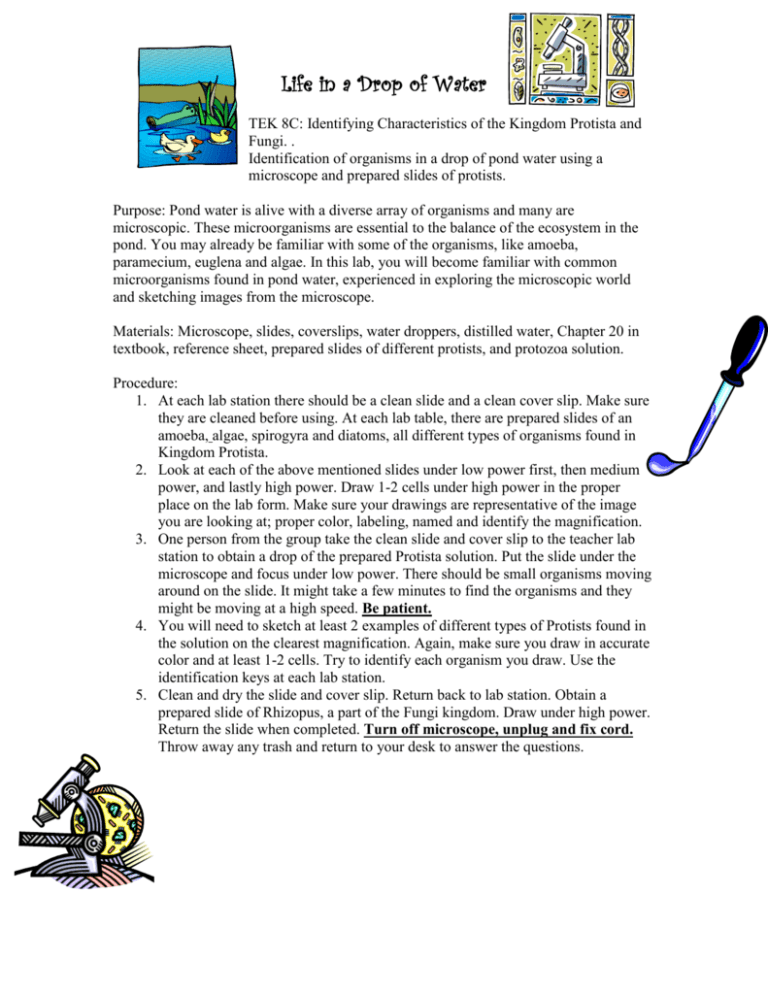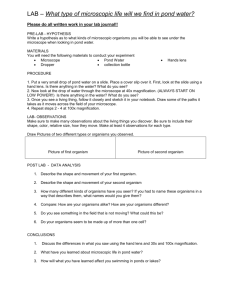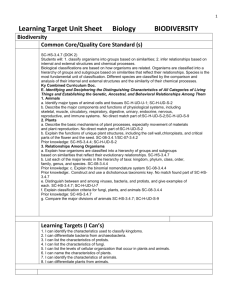Pond Water Lab - Lovejoy High School
advertisement

Life in a Drop of Water TEK 8C: Identifying Characteristics of the Kingdom Protista and Fungi. . Identification of organisms in a drop of pond water using a microscope and prepared slides of protists. Purpose: Pond water is alive with a diverse array of organisms and many are microscopic. These microorganisms are essential to the balance of the ecosystem in the pond. You may already be familiar with some of the organisms, like amoeba, paramecium, euglena and algae. In this lab, you will become familiar with common microorganisms found in pond water, experienced in exploring the microscopic world and sketching images from the microscope. Materials: Microscope, slides, coverslips, water droppers, distilled water, Chapter 20 in textbook, reference sheet, prepared slides of different protists, and protozoa solution. Procedure: 1. At each lab station there should be a clean slide and a clean cover slip. Make sure they are cleaned before using. At each lab table, there are prepared slides of an amoeba, algae, spirogyra and diatoms, all different types of organisms found in Kingdom Protista. 2. Look at each of the above mentioned slides under low power first, then medium power, and lastly high power. Draw 1-2 cells under high power in the proper place on the lab form. Make sure your drawings are representative of the image you are looking at; proper color, labeling, named and identify the magnification. 3. One person from the group take the clean slide and cover slip to the teacher lab station to obtain a drop of the prepared Protista solution. Put the slide under the microscope and focus under low power. There should be small organisms moving around on the slide. It might take a few minutes to find the organisms and they might be moving at a high speed. Be patient. 4. You will need to sketch at least 2 examples of different types of Protists found in the solution on the clearest magnification. Again, make sure you draw in accurate color and at least 1-2 cells. Try to identify each organism you draw. Use the identification keys at each lab station. 5. Clean and dry the slide and cover slip. Return back to lab station. Obtain a prepared slide of Rhizopus, a part of the Fungi kingdom. Draw under high power. Return the slide when completed. Turn off microscope, unplug and fix cord. Throw away any trash and return to your desk to answer the questions. Name _________________ Date __________________ Class Period ____________ Microorganisms Microscope Lab Protists: Amoeba Magnification _______X Protists: Diatoms Magnification _______X Protists: Algae Magnification _______X Questions: 1. Which organelle seen in these organisms is not found in bacteria? 2. What organelles allow Protists to move through their watery environment? 3. Name an organelle in algae that allows you to know that it is photosynthetic. 4. What is unique about Diatoms’ cell walls that give them a geometric appearance? Protists: Spirogyra Magnification ______X Protists Questions Continued: 5. Why is algae one of the most important organisms on earth? 6. How does Spirogyra’s name relate to its structure? Fungi: Rhizopus mold Magnification _______X Kingdom Fungi 1. What is the only unicellular fungi? 2. How do fungi obtain food? 3. Define hyphae. Pond Water Solution- Wet Mount Slide Organism #1 ________________________________ Magnification ________X Organism #2 ______________________________ Magnification ________X Analysis Questions 1. Why might some of the autotrophic organisms not survive in the classroom solution? 2. What does the hay represent in the solution of pond water? 3. What Domain and Kingdoms are most of the pond water organisms in? 4. How does the cell wall composition differ in the microscopic kingdoms? (Eubacteria, Archaebacteria, Protista, Fungi) 5. Why are many of these organisms not found in swimming pools? 6. How are fungi beneficial to the environment? 7. Differentiate between the term saprobe and parasite. 8. Compare and contrast the two kingdoms: Protista and Fungi? 9. Describe one plant disease, one human disease and one animal disease caused by a Fungus.








